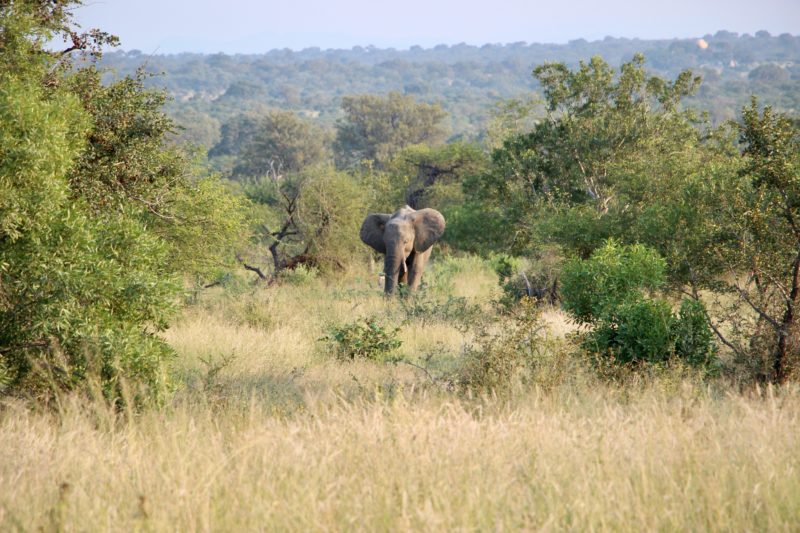The sun is setting on the day – a sherbet colored sun is growing larger as it feels its heaviness on the horizon. Our two guides in Kruger National Park, dressed in camouflage green and holding rifles, motion for us to move forward. In an open field, they stop, looking down at a sunbaked skull. “What do you think this is?” Large and shapely, the bones are sturdy and strong with a large ovular hole at the front. A rhino, alone, in the middle of the dry landscape. The ranger looks at his partner, slowly stating that this animal was poached, his life ended for his horn. Eyes cast downward, he shakes his head. A long breath ensues as the gravity of the situation sets in. Here, inside a National Park, animals are stalked in the night by two-legged creatures that see money in one piece of a rhinoceros over the value of its life in the larger hole.
Poaching is the most widely known and thought of reason for animal killing, especially in Africa. Elephants for their tusks and tails, rhinos for their horns. Pangolins for their scales, and big cats for their skins. There is still a demand for these animal products in markets across the globe: beliefs are still prevalent that ivory is a sign of wealth and that rhino horn cures medical ailments. With scientific study, we’ve found that tusks and horns are made of simple materials, dentin and keratin respectively, that are found within human makeup as well – our teeth, our hair, our fingernails. It’s with this knowledge that we must ask ourselves why these materials are so valuable, with the better understanding of what tusks and horns truly are.
Poaching sucks. Killing animals to justify and satisfy human beliefs of medicinal cures or demonstrate our wealth is unsustainable for our planet and our ecosystems. While recognizing that poaching remains a reason for population decline of many species, the question then arises about why people are killimg these animals at all. We see the demand and the trickle down of money to the hands of those who are actually poaching wildlife. They need money to live. In societies with few options to survive, individuals must turn to whatever potential moneymaking schemes are available – whether that be selling their fruits at the side of the road, chopping down trees to make coal, or killing an animal for its tusk.
While traveling in Zambia, we met with one farming community that is thriving. Mwasemphawnge, a community outside of Chipata, included 150 transformed poachers who chose to give up their firearms to learn farming and vocational skills that would support their livelihoods. When we asked them why they decided to stop poaching, they spoke about the dangers of the activity – one man noted that he had friends who were killed while poaching and others who were apprehended by law enforcement. The man went on to say how happy he is to be a part of the cooperative that gives him purpose and income, ending his need to go into the parks to slaughter animals just for their tusks and horns.
Through a long-term partnership with COMACO – Community Markets for Conservation – Mwasemphangwe is utilizing its landscapes to farm sustainably while preserving large community conservation areas so that plants and animals can continue to thrive wildly. This is just one out of many communities who are working with COMACO, a response to conservation that works with the support of 179,000 farmers in Zambia’s Luangwa Valley.
COMACO requires contractual agreements signed by communities and community members that state that they will no longer poach. In exchange, COMACO will purchase their crops that are then sold in stores to consumers. By working hand-in-hand with the communities and the chiefdoms, COMACO audits these communities to ensure they have indeed ended their poaching activities and thereby can partake in the benefits. By having this outlet to generate income, communities are living with their wildlife and are prospering, creating a life where they can meet their needs and provide for their families.
What difference would it have made if, in 2005, 10-year old African children were taught the importance of their natural resources and wildlife? Would they have appreciated these animals more? Would there be fewer cases of poaching? Would more elephants and rhinos be alive today? While we can’t go back in time, we can recognize and support the efforts that are supporting conservation efforts in a multitude of ways. Setting up national parks and good fencing is one way, educating children about the importance of wildlife is another, and providing outlets for sustainable sources of income is one more. These are just a few of the solutions that are mitigating risks and conserving Earth’s most vital resources.
There is not just one solution to caring for our planet, the problems must be addressed on many fronts. In a time when we have so much information at our fingertips and so much power as a consumer in what we choose to buy and not to buy, we are the stewards of our children’s future. It is sobering to learn that up to one million species are threatened in the sixth mass extinction in Earth’s history. Human threat is accelerating the decline and depletion of many of our plant and animal populations – while we can point fingers at poaching, we must also look at our choices every day and use our actions to stand up for what we believe in, protecting those who have no voice.




